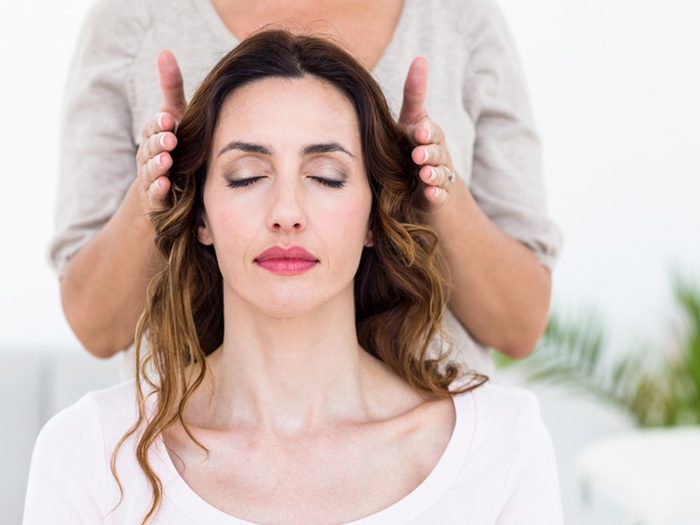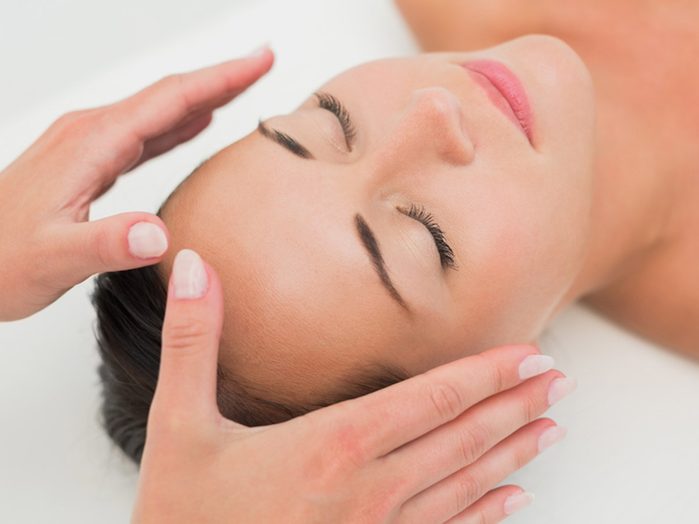
The power of “healing hands”
It was a foul winter’s day when I went grumping and limping into my first-ever reiki treatment session. My knee hurt from having twisted it. My skin itched from an ongoing case of hives. I had come very close, that morning, to kicking my cat. I was in a classic January temper, the kind only those of us in northern climes can work ourselves into. But the young reiki practitioner who answered the door of her home clinic was warm and gentle.
I had heard about Angela Toccalino, Reiki Master, from a mutual friend, as being a particularly gifted practitioner of what is broadly called “energy medicine,” a field that includes Japanese reiki, the Chinese practice of qigong and the Western approach of “healing hands” or “therapeutic touch.”
You may have seen energy medicine on offer, as it increasingly is, at spas. The practice is also making inroads in traditional healthcare settings, including medical offices, hospitals and clinics. Practitioners lay their hands either lightly on or just above people’s bodies, attempting to redirect the flow of an invisible energy that science hasn’t established exists.
You’ll need more than one reiki treatment
The idea (which you pretty much have to take on faith) is that we have a vital life force flowing through us, and that energy – ki or qi or what is called prana in India can sometimes be blocked, disturbed or mischannelled.
Energy medicine practitioners say they balance that energy flow in a manner that is supposed to promote healing, generally over five or six visits. Of course, you wouldn’t use it to treat, say, cancer, although people have used it as a complementary therapy to help with anxiety and the side effects of chemo.
But, more usually, you would try it for the relief of minor aches, pains and tension headaches; the calming of skin conditions; the settling of your digestive system, any ailment that has a strong mind-body connection.
Medical perspective on reiki treatment
Energy medicine has been practised for thousands of years, but how it works is anyone’s guess. Perhaps it’s as simple as a placebo effect: If you believe you’re being treated, you feel better.
From a medical research perspective, this concept of life force is referred to as a “putative energy field,” meaning it’s yet to be proven. There aren’t any known methods to measure it, and because of this, the whole area is often pooh-poohed by health experts.
Joe Schwarcz, director of the McGill University Office for Science & Society, says it isn’t even theoretically possible to have blocked and unblocked energy flowing around at the cellular level of the body. The concept, Schwarcz says categorically, “is sheer lunacy.”
Nevertheless, studies have tried to look more closely at what’s going on, according to the U.S. National Center for Complementary and Alternative Medicine (NCCAM), a department of the National Institutes of Health.
One way of determining whether energy is somehow being redirected is to measure naturally occurring levels of radiation in the body.
Working with this idea, studies cited by NCCAM have “identified statistically significant decreases in gamma rays emitted from patients during alternative healing sessions.” This would seem to suggest that energy had indeed been drawn out by the practitioners. (I assume it’s a good thing to lose all of your gamma rays?)

Does reiki treatment really work?
All I know is that when Angela bid me lie down on her massage table, even with all of my clothes on and her hands held about four inches above my forehead, I could feel heat coming from her palms as palpably as if I were basking under a reptile lamp. Try that at home. See if you can make your partner or a friend feel obvious heat from your hands at that distance. I held out my hands and tried it on my husband and he was like, “What the hell are you doing? I’m trying to watch the hockey game.” Maybe he would have felt something if I were running a fever. The point is, it’s an uncanny skill.
Angela says she first realized she had something going on when she was 16 years old, and a friend sprained his ankle at her house. She wrapped a hand around his foot to comfort him, she recalls, and his pain abruptly vanished. “It scared the hell out of me,” she says.
Years later, she encountered reiki, and trained to become a Master Practitioner. (You can find a teacher through the Canadian Reiki Association, based in Burnaby, B.C.) “I function as a channel,” she explains, “so that energy comes through me and out of my hands.”
This she does in a candle-lit room sonorous with spa muzak. (Well, that’s what I call it. You know those vague, Tibetan-sounding gongs and pings?)
As I reclined on her table with my eyes closed, she walked around me very slowly and purposefully, from my head to my toes, stopping at various stations along the way to hold her hands above me, or to quietly rest them on top of a certain place.
Angela is as slender and graceful as a deer, and moves just as soundlessly.
The process behind reiki treatment
Later, she explained the process. “When I find areas of the body that need attention, there are several things going on for me.
Usually, I will feel an energetic shift in my hands. For example, they might become very hot, or start to feel a very thick or dense energy. When I feel that the hot, tingly, dense or electrical sensations have subsided in my palms and come back to normal, it is my cue to move on,’” she says, adding that it’s tricky to describe such “ethereal feelings.”
Angela worked on me for an hour, during which time I decided upon and then discarded about six ideas for dinner, worried about the economy, wondered when my son would need braces and rehashed the plot of the most recent episode of House.
At length, she told me I could get up when I felt ready, and I discovered I had no inclination whatever to move. I hadn’t noticed how much she’d relaxed me.
Eventually, as I came downstairs to fetch my coat and pay my $75, I asked what she felt she had treated. (It was hard to tell yet whether my knee was better, since the pain tended to come and go.)
She mentioned, lightly and politely, the sheer busy-ness of my brain. And also that she’d picked up on issues to do with anger, and my liver.
This took me aback, because I had just had blood work done to monitor my liver enzymes, which were slightly elevated due to medication. Coincidence? Or could she really be discerning some sort of vibrational jam-up or density in my liver?
Coincidence or not?
Over the next few days, without giving further thought to the reiki treatment, I grew aware of three improvements in my general well-being. My mood was brighter, my knee now no longer hurt and my skin, which is prone to urticaria (chronic hives), remained smooth, although it flared up again a couple of months later.
In an email, Angela commented: “I generally find, with this type of subtle work, that the body also heals subtly. In each session, the individual’s energy level is raised to a higher vibration, which then gradually affects the person as a whole.”
That may be so. Or it could be the placebo effect at work, or even the relaxing experience of taking a time out to lie down on a table for an hour. Is it worth the money?
Until science can nail down the efficacy of energy medicine, I’d say it’s something to consider as a complement to, but not a substitute for, working with your doctor.
As for Angela, may the force be with her!
